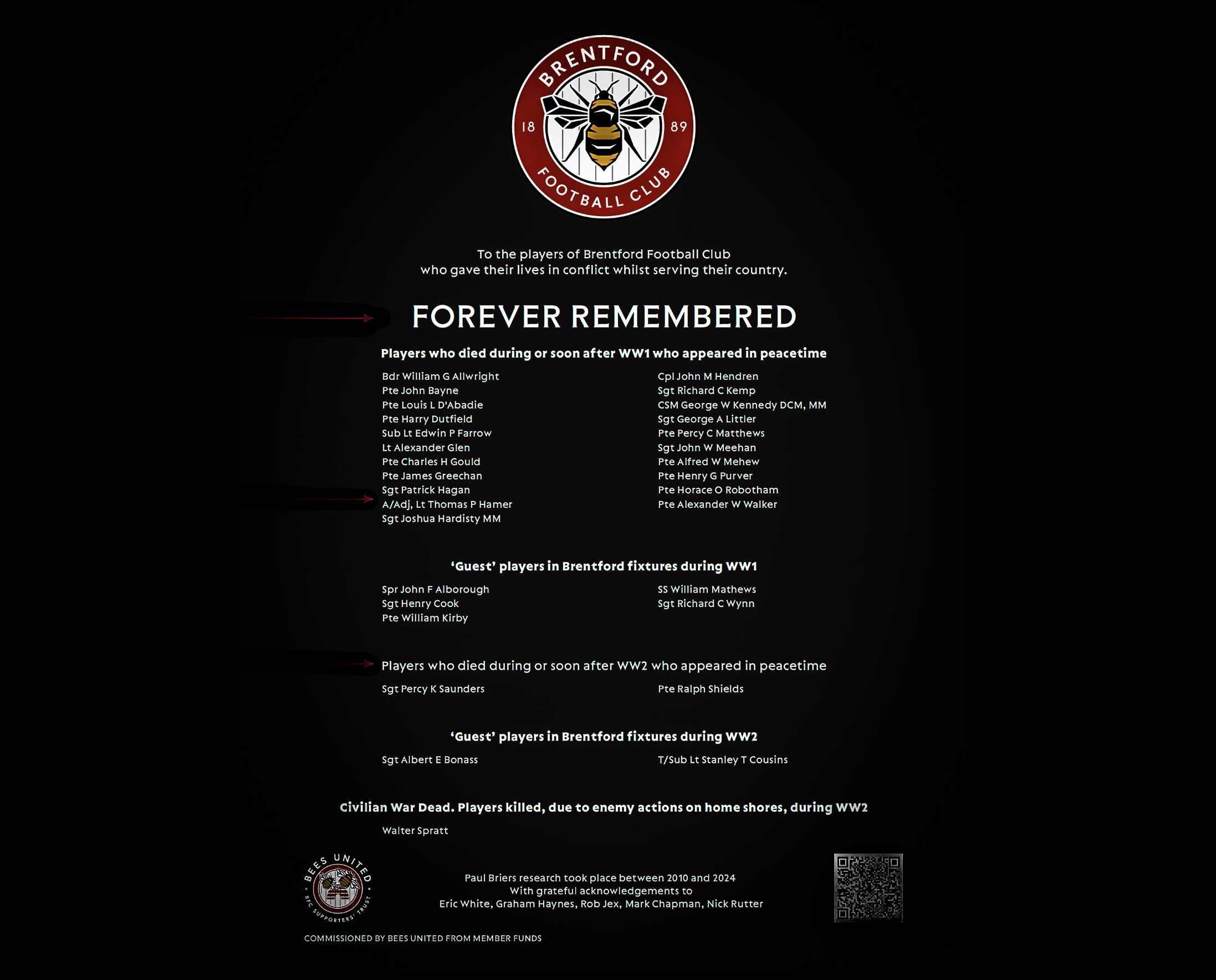Bees United remembers the players who appeared for Brentford FC, in peacetime and in war, and as guests, who lost their lives during the two World Wars and as a result of conflict. Our newest plaque is the recognition othe sacrifices of thirty one Brentford players, lost in conflict. Please visit the plaque which is behind West Stand near to the corner of North Stand.
Paul Briers has been supporting the Bees since 1973/74 and has been a season ticket holder, mostly since the late 1970’s, initially as a junior Bee. Paul’s Mum’s family were Bees, as were her brothers and cousins, so that’s where it started and although they lived in Chiswick, Paul was born in Windmill Rd Ealing, opposite the Plough in the old police flats, Pickering House, so Paul was born ‘within the sound’ of Griffin Park.
For the past fourteen years Paul, club historian, has researched all available resources to identify those players who made the ultimate sacrifice and his work began around Remembrance Day, November 2010. A post on the, Griffin Park Grapevine, created by Paul O’Brien
“Reading about the footballers who went into the Great War and gave their lives …. led me to wonder,
how many Bees players fought in the First World War and were there any tales of heroism ..”
Mark Chapman and fellow historian replied;
“In World War Two, Percy Saunders, who signed for us in 1939 from Sunderland, died in action in 1942.
From the First World War, there are at least two but perhaps some more unfortunately
my studies are not complete – Henry George Purver and Horace Osborne Robotham.”
Paul’s work began. Here are brief biographies of just some of our 31 players thus far known. Bees UnIted will published Paul’s complete researches soon and Paul’s work continues.
Bombardier William George Allwright 22710.
Born, Brentford 9th May 1880, William lived all his life in Brentford and Hammersmith. William married Alice Ralph on Christmas Day 1908 in Shepherd’s Bush.
William appeared for Brentford, as a forward, in the Southern League during the 1899/1900 season. He formerly played for Brentford Thursday, Brentford’s third team during this era. He also appeared in the West London League for Brentford reserves. The following season, 1900/1901, William appeared in one London League fixture. In total he made six appearances, scoring one goal, for the first eleven.
On 9 April 1902, William Allwright attested in London and joined the Royal Field Artillery (RFA).
Bombardier Allwright returned to the UK on 29 February 1916 having spent a year and 190 days in France. On 1 March 1916 he was posted to 5C Reserve Brigade RFA and spent nearly 100 days at home before he was discharged from service on 16 September 1916, as a Bombardier. His discharge notice says; “physically unfit for service”.
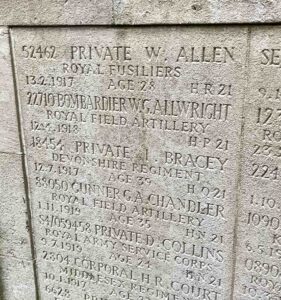
In 1916 his family were living at 16 Mafeking Avenue Brentford. He’s noted in the baptism records, for twins Ivy and Lily, as a munitions worker.
Records for 1917 show us that he was claiming a pension for himself and his children.
William George Allwright died on 12 April 1918. He is recognised by the CWGC as his death was aggravated by War service.
On 20 April 1918, William Allwright was buried in South Ealing Cemetery, Soldiers Corner, Grave Number: 21p.
Private Louis Lawrent D’Abadie SPTS/2276.
Louis was born on 10 August 1877 in Port of Spain Trinidad. His arrival into the UK isn’t known but during 1887, he was known to be a student at Stonyhurst College Clitheroe Lancashire and he completed his education at St Augustine’s College Ramsgate Kent.
During October 1896, Louis D’Abadie started to appear for Brentford in reserve fixtures in the West Middlesex League.
He may well have been introduced to Brentford via a fellow Trinidadian, Felix Leotaud, who was Captain of the Brentford Reserve XI.
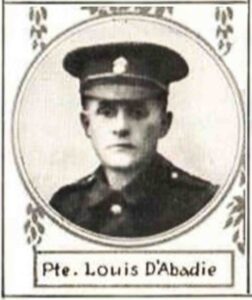
Louis returned to Trinidad and he returned to the Port of London on 8 December 1914 with fellow friends from his home country.
He enlisted into the 24th Battalion (2nd Sportsmen’s) Royal Fusiliers (City of London) Regiment, as Private SPTS/2276, in London.
Thanks to near service numbers, with surviving records, 2099 joined on 3rd December 1914 and 2293 joined on 6th January 1915. Therefore an enlistment in January 1915 is most likely.
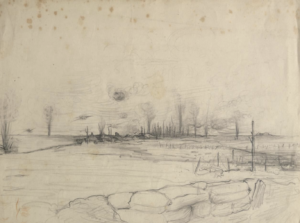
Waterlot farm, a smoking, charred forest area from behind a wall of sandbags
On 31 July 1916 the Royal Fusiliers attacked a section of German trenches to the east of Waterlot Farm, receiving many casualties. Private L. L. D’Abadie was killed when going “over the top” with his regiment to help to capture Delville Wood.
D’Abadie has no known grave and is therefore remembered on the Thiepval Memorial, Department de la Somme Picardie France. On Pier and Face 8C 9A and 16A.
In addition, he is also commemorated on the Port of Spain Cenotaph Trinidad and Tobago.
Sergeant Patrick Hagan 3004.
Patrick was born on October 1879 in St Giles Edinburgh Midlothian Scotland. He married Mary Ann O’Connor on 8 June 1904 in Edinburgh and they had four children.
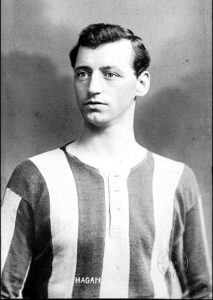 Hagan’s football career started off in Ireland, where the Royal Scots were in barracks, at Linfield FC in 1899. On 5 May 1905,
Hagan’s football career started off in Ireland, where the Royal Scots were in barracks, at Linfield FC in 1899. On 5 May 1905,
Hagan returned to Scotland and signed for Hibernians. Just a season later, in May 1906, Hagan was transferred to Brentford. Over two seasons, Patrick made a total of 71 appearances, scoring 12 goals.
He left Brentford and re-joined Hibernians FC in February 1908. After just a few months at Hibs he signed for Port Glasgow Athletic. He spent two seasons (1908 to 1910) with Port Glasgow Athletic before a pay dispute with Port Glasgow, due to industrial issues, and ended his time with them.
On 10 August 1898, Patrick Hagan enlisted into the 1st Battalion Royal Scots (Lothian Regiment). He served with his Battalion in South Africa until discharged on 26 December 1902.
On 11 August 1914, knowing he had served his country previously in the Boer War, Patrick Hagan enlisted into the Royal Scots. His service record states; missing on 14 July 1916. Then, on 12 August 1916, Hagan is recorded as; Killed in Action on 14 July 1916.
If Hagan’s date of death is taken as 14 July, then he was killed either during the early morning attack or whilst in one of the patrols that attacked the German positions. Sergeant Patrick Hagan 3004 has no known grave and is remembered on the Thiepval Memorial; Pier and Face 6 D and 7 D.
Company Sergeant Major George William Kennedy DCM MM
George was born on 12 March 1882 in Maxwelltown Kirkcudbrightshire Scotland.
George appeared for a junior club in Kirkcudbrightshire, Maxwelltown Volunteers FC, as a half-back. This football club was formerly the 5th Kirkcudbrightshire Rifle Volunteers Football Club. In 1906 George was signed by Football League club Lincoln City. After two years at Sincil Bank, George was signed by Chelsea in May 1908 but a serious knee injury curtailed his Chelsea career.
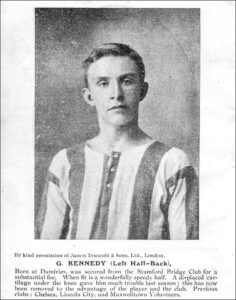 In July 1910, George was given a chance by Brentford FC to appear in the Southern League and get his football career going again. He spent two and a half seasons at Brentford, appearing in 78 Southern League and FA Cup ties, scoring two goals, before being released mid-season in January 1913. He returned to Scotland and in late January 1913 he appeared for Dumfries FC up to 1914.
In July 1910, George was given a chance by Brentford FC to appear in the Southern League and get his football career going again. He spent two and a half seasons at Brentford, appearing in 78 Southern League and FA Cup ties, scoring two goals, before being released mid-season in January 1913. He returned to Scotland and in late January 1913 he appeared for Dumfries FC up to 1914.
George Kennedy emigrated to Canada on 23 May 1914, leaving Glasgow on board the Grampian for Montreal. His occupation is noted as plasterer. He arrived in Quebec on 1 June 1914.
On 4 March 1915, in Montreal, Kennedy enlisted into the Canadian Infantry, 42nd Battalion (Royal Highlanders) Quebec Regiment.
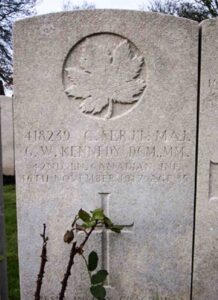
On 16 November 1917, at around 12:30am, he was sent to No.9 Canadian Field Hospital Passchendaele Belgium with a fatal shell wound to the face from a enemy action.
Kennedy is buried at Lijssenthoek Military Cemetery Ypres Belgium. Grave Ref. XXII-DD-12A.
He was awarded the Military Medal, For Bravery in the Field (London Gazette – 27/10/1916). Later awarded the Distinguished Conduct Medal for Conspicuous gallantry & devotion to duty (London Gazette – 1/1/1917).
Sergeant John William Meehan 4800
John Meehan was born on 19 April 1891 in Over Darwen Lancashire. In 1911 he was a Printers Assistant, at the Amalgamated Press works in Gravesend Kent.
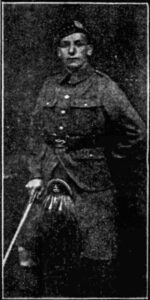
John is noted as signing for Brentford in January 1913 from Darwen FC.
This was after a recommendation by former Brentford Captain, George Parsonage. Meehan came on trial along with another player, George Carter.
Meehan appeared mostly for the reserves, in the South-Eastern League, during 1913/1914. He would appear in just two first team fixtures during this season before leaving, in August 1914, to join Stalybridge Celtic FC, who were also in the Southern League Second Division.
He attested on 9 June 1915 in Liverpool and became a Private in B Company 3/10 (Scottish) The King’s Liverpool Regiment.
His time in France amounted to nine months. John was wounded in action on 9 August 1916. He suffered a serious wound to his left groin.
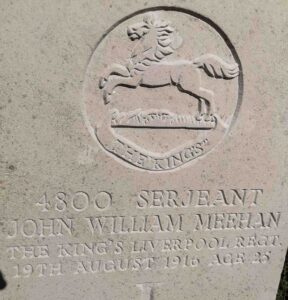
He was taken to the 13th Corps Dress Station and then to the 21st Casualty Clearing Station.
Before being transported to No.5 General Hospital in Rouen.Ten days later, on 19 August 1916, he died of his injuries at 6:30am.
Meehan was laid to rest at St. Sever Cemetery Rouen France.
His grave number is B. 27. 30.
The above are just five of the thirty-one men to have appeared for Brentford
and who were to make the ultimate sacrifice in both World Wars
In response to the original post on the GPG back in 2010, ‘were there any tales of heroism“
there were at least 31 such tales and almost certainly more undiscovered
Players who died during or soon after WW1 who appeared in peace-time
Bombardier William George Allwright
Private John Bayne
Private Louis Lawrent D’Abadie
Private Harry Dutfield
Sub-Lieutenant Edwin Percy Farrow
Lieutenant Alexander Glen
Private Charles Henry Gould
Private James Greechan
Sergeant Patrick Hagan
Acting Adjutant, Lieutenant Thomas Pryce Hamer
Sergeant Joshua Hardisty MM
Corporal John Michael Hendren
Sergeant Richard Charles Kemp
Company Sergeant
Major George William Kennedy DCM, MM
Sergeant George Albert Littler
Private Percy Charles Matthews
Sergeant John William Meehan
Private Alfred William Mehew
Private Henry George Purver
Private Horace Osborne Robotham
Private Alexander White Walker
“Guest” players in Brentford fixtures during WW1
Sapper John Frederick Alborough
Sergeant Henry Cook
Private William Kirby
Shoeing Smith William Mathews
Sergeant Richard Cross Wynn
Players who died during or soon after WW2 who appeared in peace-time
Sergeant Percy Kitchener Saunders
Private Ralph Shields
“Guest” players in Brentford fixtures during WW2
Sergeant Albert Edward Bonass
Sub-Lieutenant Stanley Tyrrell Cousins
Civilian War Dead players killed, due to enemy actions on home shores, during WW2
Walter Spratt
They shall grow not old, as we that are left grow old,
Age shall not weary them, nor the years condemn.
At the going down of the sun, and in the morning
WE WILL REMEMBER THEM
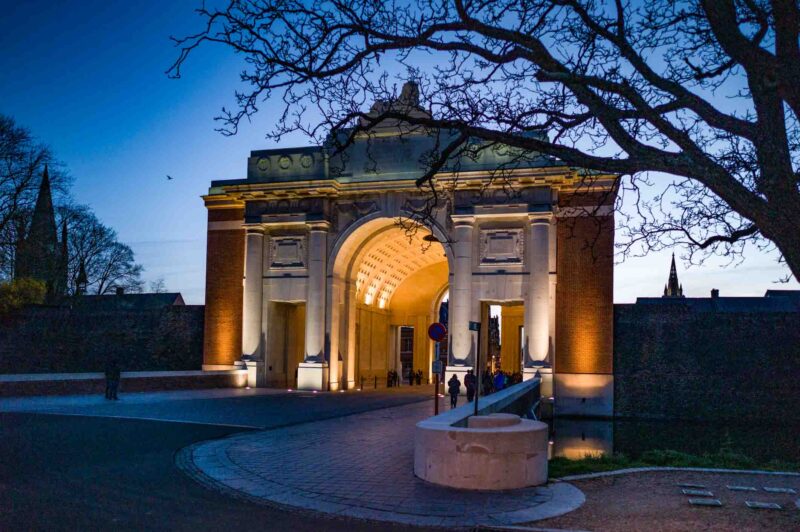
Menin Gate Ypres
Paul Briers

